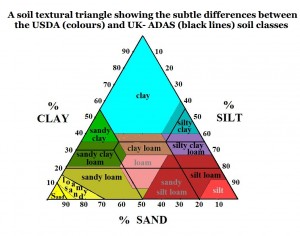Example of healthy soil. Source. (CC).
Every house has a foundation, and every foundation must be constructed efficiently, safely and correctly so it will last. The materials that make up the building block and the process of building it are equally important; however, one thing that’s often overlooked is the soilsupporting them because even foundations need a solid foundation. Each type of soil has different properties that affect foundations differently. Generally, soil will be more stable the more rock and compacted sand/gravel it contains.
A diagram showing the different soil levels.
The Types of Soils
- Peat – Peaty soil is usually dark brown or black and is easily compressible because of how much water it can hold. However, during the summer it becomes extremely dry and can even be a fire hazard. It is very poor subsoil and not ideal for support, as foundations are most stable on soil that does not shift or change structure.
- Clay – Clay is made up of tiny particles so it stores water well, but because of its tight grasp on water it expands greatly when moist and shrinks significantly when dry. When clay is moist, it is very pliable, and can easily be moved and manipulated. These extreme changes put a great deal of pressure on foundations, causing them to move up and down, and eventually crack, making clay a poor soil for support.
- Silt – Silty soil can be smooth to the touch and retains water longer because of its smaller particles. However, because of its tendency to retain moisture it is cold and drains poorly. This causes the silty soil to expand, pushing against a foundation and weakening it, making it not ideal for support.
- Sand/Gravel – Sand/gravel has the largest particles of the different soil types. It is dry and gritty to the touch and does not hold moisture because of the large openings, but drains easily. When compacted and moist it holds together fairly well, and if compacted these make for good soils to support a foundation because of their non-water-retaining properties. However, when moist, the particles will lose their friction and can be washed away, which can leave gaps beneath the foundation.
- Loam – Loam is the ideal soil type: typically it’s a combination of sand, silt and clay. It is dark in color and soft, dry and crumbly to the touch. Loam is great for supporting foundations because of its evenly balanced properties, especially how it maintains water at a balanced rate. Loam is a good soil for supporting a foundation, as long as no miscellaneous soils find their way onto the surface.
- Rock – Types such as bedrock, limestone, sandstone, shale and hard chalk have high bearing capacities. These are very strong and good for supporting foundations because of their stability and depth. As long as the rock is level the foundation will be well supported.